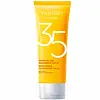What's inside
What's inside
 Key Ingredients
Key Ingredients

 Benefits
Benefits

 Concerns
Concerns

 Ingredients Side-by-side
Ingredients Side-by-side

Alcohol
AntimicrobialTocopherol
AntioxidantPantothenic Acid
Skin ConditioningWater
Skin ConditioningEthylhexyl Methoxycinnamate
UV AbsorberButyloctyl Salicylate
Skin ConditioningButyl Methoxydibenzoylmethane
UV AbsorberOctocrylene
UV AbsorberPropylene Glycol
HumectantHydroxyethyl Acrylate/Sodium Acryloyldimethyl Taurate Copolymer
Emulsion StabilisingTocopheryl Acetate
AntioxidantPhenoxyethanol
PreservativeSodium Acrylates Copolymer
Chlorphenesin
AntimicrobialPropanediol
SolventLecithin
EmollientAllantoin
Skin ConditioningPanthenol
Skin ConditioningDisodium EDTA
Parfum
MaskingEthylhexylglycerin
Skin ConditioningArtemisia Capillaris Flower Extract
Skin ConditioningAlcohol, Tocopherol, Pantothenic Acid, Water, Ethylhexyl Methoxycinnamate, Butyloctyl Salicylate, Butyl Methoxydibenzoylmethane, Octocrylene, Propylene Glycol, Hydroxyethyl Acrylate/Sodium Acryloyldimethyl Taurate Copolymer, Tocopheryl Acetate, Phenoxyethanol, Sodium Acrylates Copolymer, Chlorphenesin, Propanediol, Lecithin, Allantoin, Panthenol, Disodium EDTA, Parfum, Ethylhexylglycerin, Artemisia Capillaris Flower Extract
Water
Skin ConditioningDimethicone
EmollientZinc Oxide
Cosmetic ColorantButylene Glycol
HumectantEthylhexyl Methoxycinnamate
UV AbsorberAlcohol
AntimicrobialC12-15 Alkyl Benzoate
AntimicrobialGlycerin
HumectantBis-Ethylhexyloxyphenol Methoxyphenyl Triazine
Skin ConditioningDiethylamino Hydroxybenzoyl Hexyl Benzoate
UV FilterPEG-100 Hydrogenated Castor Oil
EmulsifyingHoney
HumectantOryza Sativa Germ Oil
EmollientSodium Hyaluronate
HumectantSericin
Skin ConditioningSodium Acetylated Hyaluronate
HumectantCamellia Sinensis Leaf Extract
AntimicrobialPPG-17
Skin ConditioningIsostearic Acid
CleansingTriethoxycaprylylsilane
Sorbitan Sesquiisostearate
EmulsifyingEthylhexyl Triazone
UV AbsorberDextrin Palmitate/Ethylhexanoate
EmulsifyingSilica
AbrasiveSodium Acrylate/Sodium Acryloyldimethyl Taurate Copolymer
Emulsion StabilisingSuccinoglycan
Skin ConditioningHydroxypropyl Methylcellulose Stearoxy Ether
Isohexadecane
EmollientCitric Acid
BufferingBHT
AntioxidantDisodium EDTA
Polysorbate 80
EmulsifyingCitrus Aurantium Dulcis Peel Oil
MaskingTocopherol
AntioxidantSorbitan Oleate
EmulsifyingSodium Citrate
BufferingSodium Metabisulfite
AntioxidantPotassium Sorbate
PreservativePhenoxyethanol
PreservativeWater, Dimethicone, Zinc Oxide, Butylene Glycol, Ethylhexyl Methoxycinnamate, Alcohol, C12-15 Alkyl Benzoate, Glycerin, Bis-Ethylhexyloxyphenol Methoxyphenyl Triazine, Diethylamino Hydroxybenzoyl Hexyl Benzoate, PEG-100 Hydrogenated Castor Oil, Honey, Oryza Sativa Germ Oil, Sodium Hyaluronate, Sericin, Sodium Acetylated Hyaluronate, Camellia Sinensis Leaf Extract, PPG-17, Isostearic Acid, Triethoxycaprylylsilane, Sorbitan Sesquiisostearate, Ethylhexyl Triazone, Dextrin Palmitate/Ethylhexanoate, Silica, Sodium Acrylate/Sodium Acryloyldimethyl Taurate Copolymer, Succinoglycan, Hydroxypropyl Methylcellulose Stearoxy Ether, Isohexadecane, Citric Acid, BHT, Disodium EDTA, Polysorbate 80, Citrus Aurantium Dulcis Peel Oil, Tocopherol, Sorbitan Oleate, Sodium Citrate, Sodium Metabisulfite, Potassium Sorbate, Phenoxyethanol
 Reviews
Reviews

Ingredients Explained
These ingredients are found in both products.
Ingredients higher up in an ingredient list are typically present in a larger amount.
Alcohol comes in many different forms. Different types of alcohol will have different effects on skin. This ingredient is usually an astringent alcohol.
These alcohols are drying on the skin. They may strip away your skin's natural oils and even damage your skin barrier. Astringent alcohols may also irritate skin.
Other types of astringent alcohols include:
According to the National Rosacea Society based in the US, you should be mindful of products with these alcohols in the top half of ingredients.
Any type of sanitizing product will have high amounts of alcohol to help kill bacteria and viruses.
Fatty alcohols come from plant oils such as coconut oil. These can help hydrate the skin and are non-irritating. Some fatty alcohols include cetyl and stearyl alcohol.
Learn more about AlcoholDisodium EDTA plays a role in making products more stable by aiding other preservatives.
It is a chelating agent, meaning it neutralizes metal ions that may be found in a product.
Disodium EDTA is a salt of edetic acid and is found to be safe in cosmetic ingredients.
Learn more about Disodium EDTAEthylhexyl Methoxycinnamate is an organic compound that provides UVB protection. It often goes by the more common name of octinoxate. It is created from methoxycinnamic acid and 2-ethylhexanol.
Ethylhexyl Methoxycinnamate absorbs UVB rays with wavelengths between 280-320 nm. UV absorbers protect your skin by using chemical reactions to convert UV rays into heat and energy.
UVB (290-320 nm) rays emit more energy than UVA rays. They are capable of damaging DNA, causing sunburns and are thought to be linked to skin cancer.
The state of Hawaii has banned sunscreens containing octinoxate due to its potential impact on coral reefs. More research is needed to bridge gaps in this research. The European Union allows higher levels of octinoxate in sunscreens than the US and Australia.
Ethylhexyl Methoxycinnamate is oil soluble. It is not stable and may lose efficacy when exposed to sunlight.
Learn more about Ethylhexyl MethoxycinnamatePhenoxyethanol is a preservative that has germicide, antimicrobial, and aromatic properties. Studies show that phenoxyethanol can prevent microbial growth. By itself, it has a scent that is similar to that of a rose.
It's often used in formulations along with Caprylyl Glycol to preserve the shelf life of products.
Tocopherol (also known as Vitamin E) is a common antioxidant used to help protect the skin from free-radicals and strengthen the skin barrier. It's also fat soluble - this means our skin is great at absorbing it.
Vitamin E also helps keep your natural skin lipids healthy. Your lipid skin barrier naturally consists of lipids, ceramides, and fatty acids. Vitamin E offers extra protection for your skin’s lipid barrier, keeping your skin healthy and nourished.
Another benefit is a bit of UV protection. Vitamin E helps reduce the damage caused by UVB rays. (It should not replace your sunscreen). Combining it with Vitamin C can decrease sunburned cells and hyperpigmentation after UV exposure.
You might have noticed Vitamin E + C often paired together. This is because it is great at stabilizing Vitamin C. Using the two together helps increase the effectiveness of both ingredients.
There are often claims that Vitamin E can reduce/prevent scarring, but these claims haven't been confirmed by scientific research.
Learn more about TocopherolWater. It's the most common cosmetic ingredient of all. You'll usually see it at the top of ingredient lists, meaning that it makes up the largest part of the product.
So why is it so popular? Water most often acts as a solvent - this means that it helps dissolve other ingredients into the formulation.
You'll also recognize water as that liquid we all need to stay alive. If you see this, drink a glass of water. Stay hydrated!
Learn more about Water